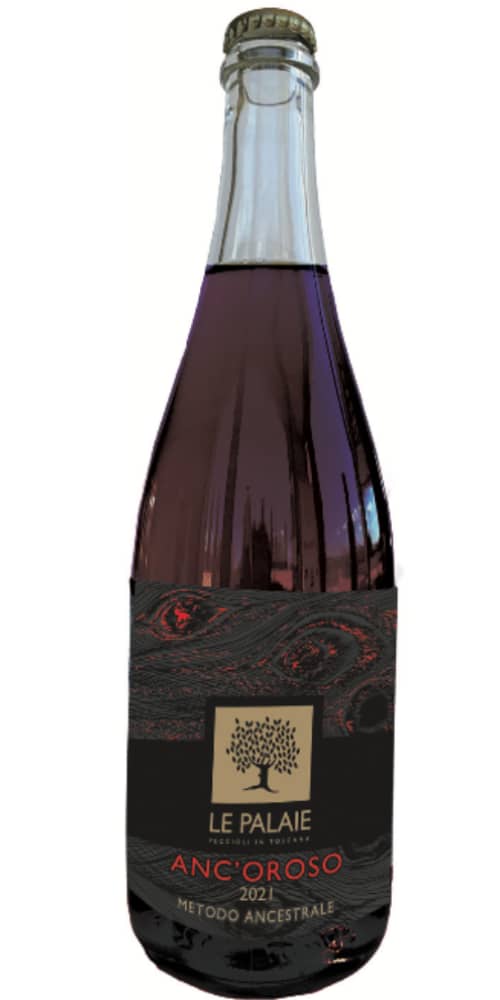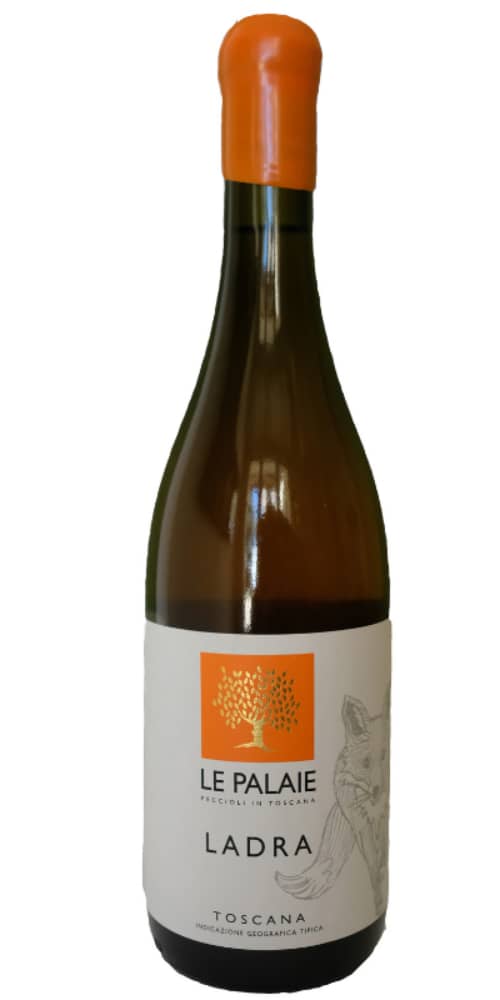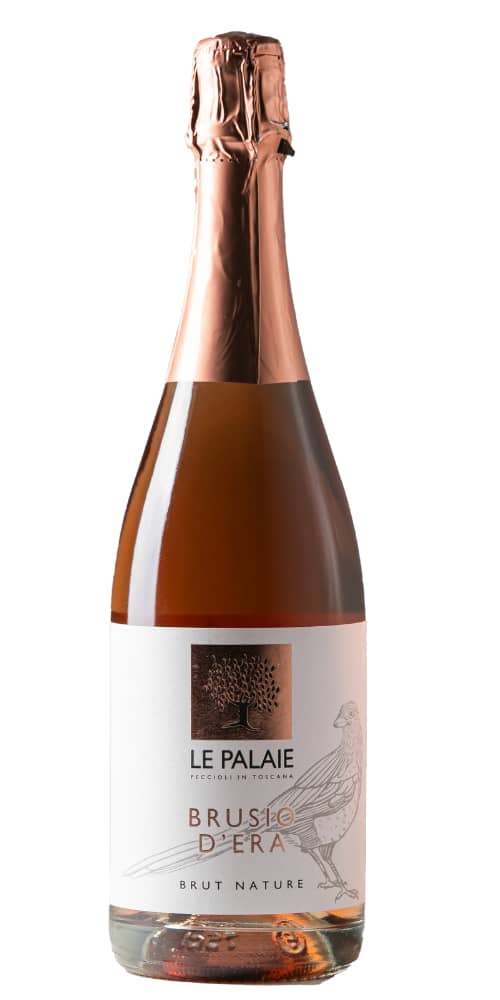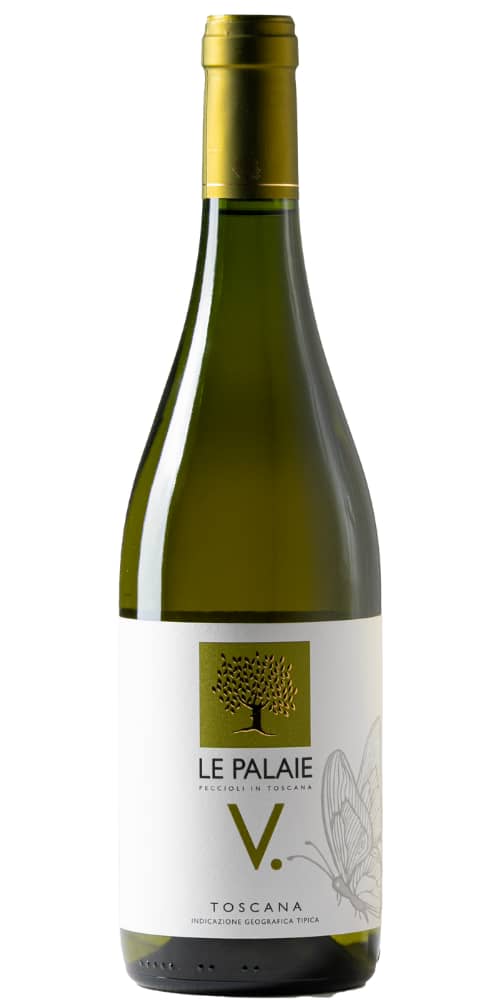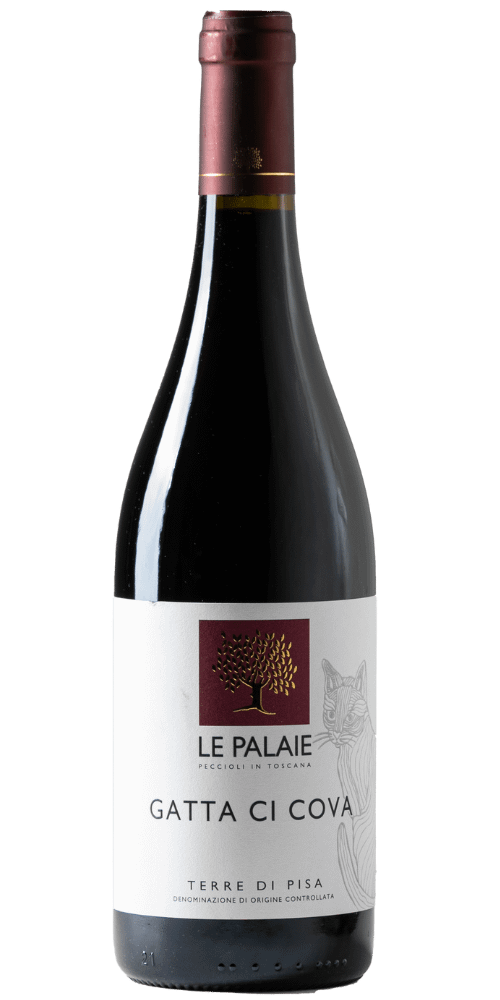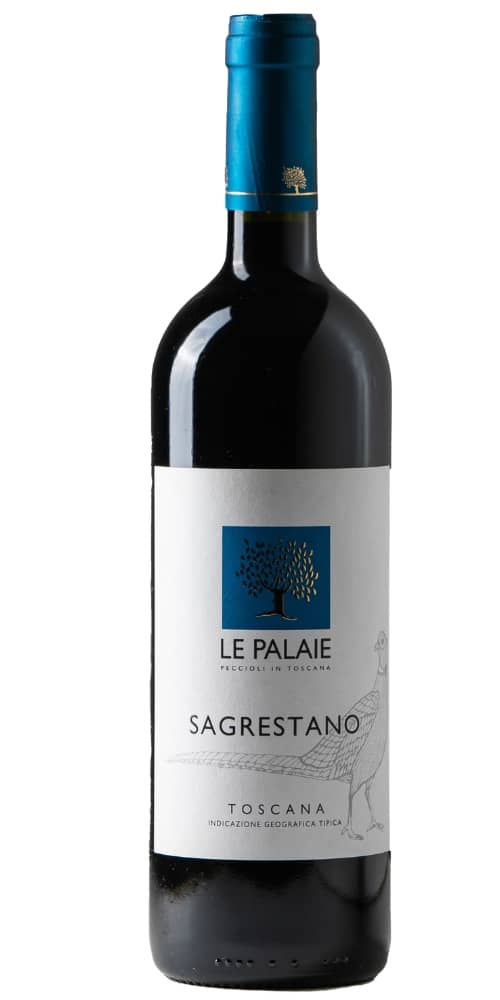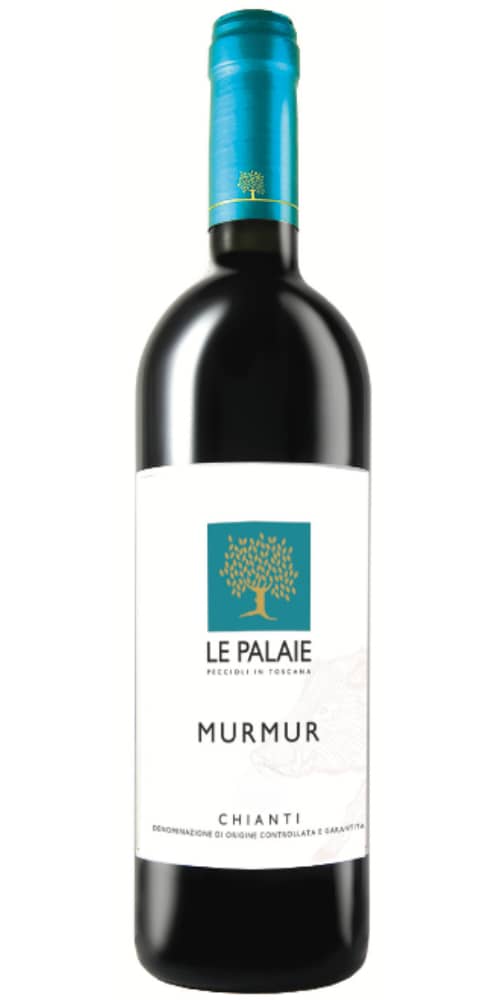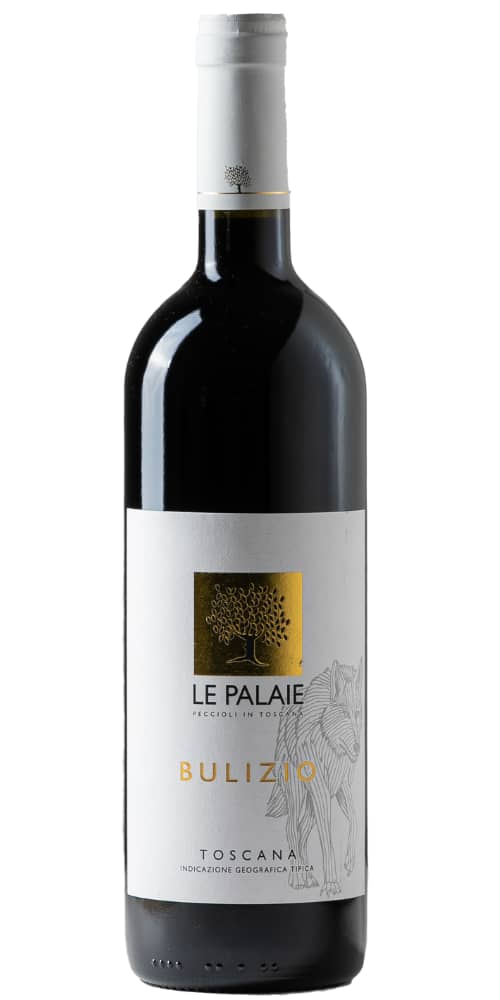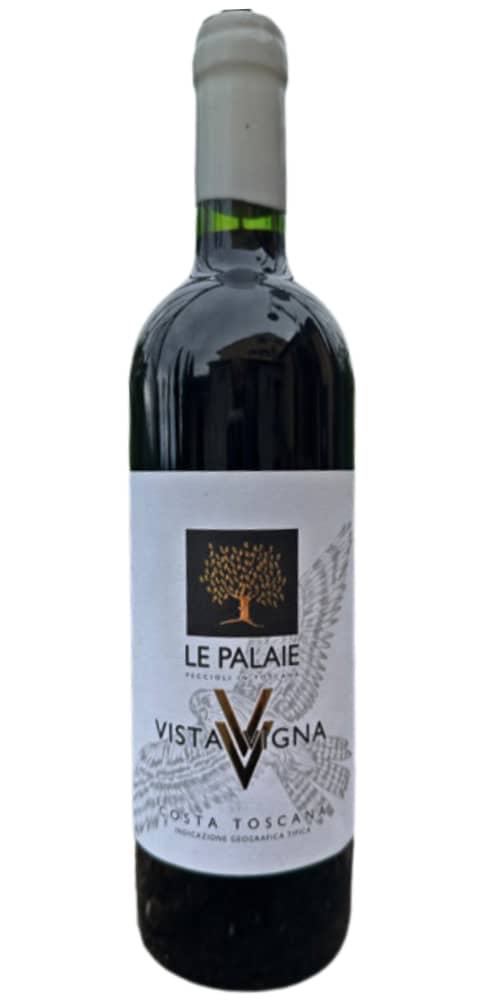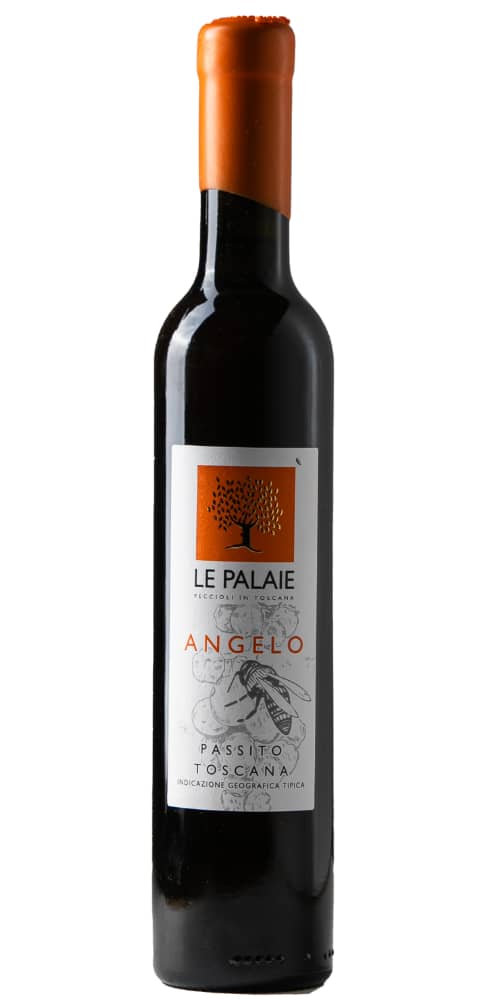Wines
Val d’Era is an area highly specialised in wine production and Le Palaie estate is a part of the Tuscan oenological tradition. A wide variety and quality of grapes can only result in the production of numerous wines of a high-level. An array of wines to be enjoyed There are eleven wines to enjoy: an experience not to be missed..
- % VOL: 12
- GRAPE VARIETIES: Alicante Bouschet
- VINEYARD DENSITY: 5.000 vigna/ectare
- ALTITUDE: 200 mt.
- SENSORY PROFILE: The colour is reminiscent of pink coral and its slight cloudiness is due to the presence of suspended yeasts, which create a creamy red mousse. The aromas are those of small wild red fruits and pungent spices, and on the palate it is subtle, salty and juicy.
- VINIFICATION AND AGEING:: Fermentation of the must takes place spontaneously without the addition of selected yeasts, in steel tanks. At a later stage, the must is bottled for the second fermentation. No filtration, no dosage and no bottom.
- SERVING TEMPERATURE: 10°C
- STORAGE: Store in a cool, dark place.
- FOOD PAIRING: perfect as an aperitif and in combination with white meats or tasty fish dishes.
- % VOL: 12,5
- GRAPE VARIETIES: Blend of white Tuscan grapes such as Colombana and Trebbiano
- VINEYARD DENSITY: 5.000 vigna/ectare
- ALTITUDE: 300 mt.
- SENSORY PROFILE: Orange-coloured, Ladra is an orange
wine with very complex notes ranging from dried fruit
to tobacco. On the palate it is a very viscous wine but at the
at the same time very savoury and mineral. - VINIFICATION AND AGEING: After careful selection of the grapes, the bunch is manually crushed and placed in earthenware vats. Maceration of 10/15 days phase in which the must remains in contact with the skins.
Aging in steel and bottle. After racking it is transferred to steel to carry out malolactic fermentation and aging on the lees for 8 months then 2 months in bottle. - SERVING TEMPERATURE: 12-14°C
- STORAGE: Store in a cool, dark place.
- FOOD PAIRING: To be paired with medium-aged cheeses mature cheeses or with white meat dishes if served at a slightly higher temperature.
- % VOL: 12
- GRAPE VARIETIES: Sangiovese
- VINEYARD DENSITY: 5.000 vigna/ectare
- ALTITUDE: 200 mt.
- SENSORY PROFILE: A soft, bright pink colour, the bouquet opens with floral sensations, then hints of fruit and, on the finish, toasted bread. Complex on the palate, it contrasts marked acidity with a balanced sugar content.
- VINIFICATION AND AGEING: Obtained by the long Charmat method, it is kept in contact with the yeasts for 8 months. The result is a richer aromatic complexity, also given by the low sugar dosage, which allows us to create a Brut Nature.
- SERVING TEMPERATURE: 10°C
- STORAGE: Store in a cool, dark place.
- FOOD PAIRING: perfect as an aperitif and with cold cuts.
- % VOL: 13,5
- GRAPE VARIETIES:’: Viognier
- GRAPE VARIETIES:: 5.000 vigna/ectare
- ALTITUDE: 300 mt.
- SENSORY PROFILE: Intense colour with golden hues. The bouquet alternates floral notes such as jasmine and elderflower with citrus and mineral notes. On the palate it is round with good fatness and a savoury, persistent fi
- VINIFICATION AND AGEING: Classic white vinification with alcoholic fermentation conducted at controlled temperatures (10-12°C) to enhance the wine’s aromas in
- SERVING TEMPERATURE: 10°C
- STORAGE: Store in a cool, dark place
- FOOD PAIRING: Perfect with raw fish, shellfish and seafood.
- % VOL: 13
- GRAPE VARIETIES:: Sangiovese; Merlot
- VINEYARD DENSITY: 5.000 vigna/ectare
- ALTITUDE: 200 mt.
- SENSORY PROFILE: Deep pink in colour; Thulite is a fresh rosé with character and a great concentration of aromas and flavours
- VINIFICATION AND AGEING: white fermentation with soft pressing to extract a rosé colour; alcoholic fermentation at controlled temperatures followed by ageing in
- SERVING TEMPERATURE: 8-10°C
- STORAGE: Store in a cool, dark place.
- FOOD PAIRING: Perfect with tasty fish dishes such as red soups and white meats.
- % VOL: 13,5
- GRAPE VARIETIES: Predominantly Sangiovese and remaining Tuscan red grapes
- VINEYARD DENSITY: 5.000 vigna/ectare
- ALTITUDE: 300 mt.
- SENSORY PROFILE:: Bright red in colour, Gatta ci cova is a wine with a fruity bouquet, the nose is characterised by small red fruits such as raspberries and currants. On the palate it is round and soft, the finish lingers with a marked acidity.
- VINIFICATION AND AGEING: Manual harvest; traditional red vinification with 15-day maceration in temperature-controlled cement vats. Matured for 6 months in cement vats and 6 months in the bottle.
- SERVING TEMPERATURE: 14°C
- STORAGE: Store in a cool, dark place.
- FOOD PAIRING: perfect with tasty fish soups and white meat.
- % VOL: 10
- GRAPE VARIETIES: Sangiovese; Alicante
- VINEYARD DENSITY: 5.000 vigna/ectare
- ALTITUDE: 300 mt.
- SENSORY PROFILE: Intense, full-bodied wine, with a dynamic, crisp palate; enhanced by the spicy notes of the Alicante, its finish is persistent.
- VINIFICATION AND AGEING: Traditional red vinification, with careful selection of the grapes in the vineyard. Maceration and fermentation for 15 days in steel tanks and ageing for about 12 months in French oak barrels.
- SERVING TEMPERATURE: 14°C
- STORAGE: Store in a cool, dark place.
- FOOD PAIRING: Perfect in combination with grilled red meat.
- % VOL: 13,5
- GRAPE VARIETIES:: Sangiovese; varietà toscane quali Canaiolo, Mammolo e colorino.
- VINEYARD DENSITY: 4.000 vigna/ectare
- ALTITUDE: 300 mt.
- SENSORY PROFILE: Ruby red in colour, Murmur is a wine with aromas ranging from red fruit to spices. It is well structured on the palate with velvety tannins and a clean, persistent finish.
- VINIFICATION AND AGEING: Traditional red vinification, with careful selection of grapes in the vineyard. Macerated for 15 days in cement vats and aged for about 12 months in the same cement vats.
- SERVING TEMPERATURE: 14°C
- STORAGE: Store in a cool, dark place
- FOOD PAIRING: perfect combined with grilled red meat.
- % VOL: 14
- GRAPE VARIETIES: Cabernet sauv.; merlot; petit verdot.
- VINEYARD DENSITY: 5.000 vigna/ectare
- ALTITUDE: 300 mt.
- SENSORY PROFILE: Purple-red in colour, Bulizio is a wine with an intense bouquet with fruity notes and sweet spices. On the palate it is warm and well structured with soft and persistent tannins.
- VINIFICATION AND AGEING: Traditional red wine with 15-day maceration in steel vats; aged 12 months in French oak barrels and one year in bottle.
- SERVING TEMPERATURE: 14°C
- STORAGE: Store in a cool, dark place.
- FOOD PAIRING: Perfect with tasty meat dishes, such as stews.
- % VOL: 15
- GRAPE VARIETIES:: Cabernet Franc .
- VINEYARD DENSITY: 4.000 vigna/ectare
- ALTITUDE: 300 mt.
- SENSORY PROFILE: Deep red in colour with purplish highlights, Vista Vigna has a rich and intense bouquet, ranging from ripe fruit to spicy hints from ageing. The palate is well structured with lively yet velvety and persistent tannins.
- VINIFICATION AND AGEING:: Traditional red wine with 15-day maceration in steel vats; aged 12 months in new and semi-new French oak tonneaux and one year in bottle.
- SERVING TEMPERATURE: 14°C
- STORAGE: Store in a cool, dark place.
- FOOD PAIRING: Perfect with tasty meat dishes, such as stews.
- % VOL: 13
- VARIETA’: Colombana
- SENSORY PROFILE: An orangey-gold colour that expresses all its complexity and elegance. Hints of yellow fruit, flowers, honey and tobacco leaves characterise the nose; the round and genuine palate closes with great persistence and flavour.
- VINIFICATION AND AGEING:: Obtained by the method of drying the grapes on racks, it is fermented without the addition of yeasts and aged in small wooden barrels (50 litres) made from fruit trees for 12 months.
- SERVING TEMPERATURE: 12°C
- STORAGE: Store in a cool, dark place
- FOOD PAIRING: Perfect in combination with dry pastries and cheeses.
- % VOL: 12
- GRAPE VARIETIES:: Alicante Bouschet
- VINEYARD DENSITY: 5.000 vigna/ectare
- ALTITUDE: 200 mt.
- SENSORY PROFILE: The colour is reminiscent of pink coral and its slight cloudiness is due to the presence of suspended yeasts, which create a creamy red mousse. The aromas are those of small wild red fruits and pungent spices, and on the palate it is subtle, salty and juicy.
- VINIFICATION AND AGEING:: Fermentation of the must takes place spontaneously without the addition of selected yeasts, in steel tanks. At a later stage, the must is bottled for the second fermentation. No filtration, no dosage and no bottom.
- SERVING TEMPERATURE: 10°C
- STORAGE: Store in a cool, dark place.
- FOOD PAIRING: perfect as an aperitif and in combination with white meats or tasty fish dishes.
- % VOL: 12,5
- GRAPE VARIETIES: Blend of white Tuscan grapes such as Colombana and Trebbiano
- VINEYARD DENSITY: 5.000 vigna/ectare
- ALTITUDE: 300 mt.
- SENSORY PROFILE: Orange-coloured, Ladra is an orange
wine with very complex notes ranging from dried fruit
to tobacco. On the palate it is a very viscous wine but at the
at the same time very savoury and mineral. - VINIFICATION AND AGEING: After careful selection of the grapes, the bunch is manually crushed and placed in earthenware vats. Maceration of 10/15 days phase in which the must remains in contact with the skins.
Aging in steel and bottle. After racking it is transferred to steel to carry out malolactic fermentation and aging on the lees for 8 months then 2 months in bottle. - SERVING TEMPERATURE: 12-14°C
- STORAGE: Store in a cool, dark place.
- FOOD PAIRING: Da abbinare con formaggi mediamente stagionati o con piatti a base di carne bianca se servito ad una temperatura leggermente più alta.
- % VOL: 12
- GRAPE VARIETIES: Sangiovese
- VINEYARD DENSITY: 5.000 vigna/ectare
- ALTITUDE: 200 mt.
- SENSORY PROFILE: A soft, bright pink colour, the bouquet opens with floral sensations, then hints of fruit and, on the finish, toasted bread. Complex on the palate, it contrasts marked acidity with a balanced sugar content.
- VINIFICATION AND AGEING: Obtained by the long Charmat method, it is kept in contact with the yeasts for 8 months. The result is a richer aromatic complexity, also given by the low sugar dosage, which allows us to create a Brut Nature.
- SERVING TEMPERATURE: 10°C
- STORAGE: Store in a cool, dark place.
- FOOD PAIRING: perfect as an aperitif and with cold cuts.
- % VOL: 13,5
- GRAPE VARIETIES:’: Viognier
- GRAPE VARIETIES:: 5.000 vigna/ectare
- ALTITUDE: 300 mt.
- SENSORY PROFILE: Intense colour with golden hues. The bouquet alternates floral notes such as jasmine and elderflower with citrus and mineral notes. On the palate it is round with good fatness and a savoury, persistent fi
- VINIFICATION AND AGEING: Classic white vinification with alcoholic fermentation conducted at controlled temperatures (10-12°C) to enhance the wine’s aromas in
- SERVING TEMPERATURE: 10°C
- STORAGE: Store in a cool, dark place
- FOOD PAIRING: Perfect with raw fish, shellfish and seafood.
- % VOL: 13
- GRAPE VARIETIES:: Sangiovese; Merlot
- VINEYARD DENSITY: 5.000 vigna/ectare
- ALTITUDE: 200 mt.
- SENSORY PROFILE: Deep pink in colour; Thulite is a fresh rosé with character and a great concentration of aromas and flavours
- VINIFICATION AND AGEING: white fermentation with soft pressing to extract a rosé colour; alcoholic fermentation at controlled temperatures followed by ageing in
- SERVING TEMPERATURE: 8-10°C
- STORAGE: Store in a cool, dark place.
- FOOD PAIRING: Perfect with tasty fish dishes such as red soups and white meats.
- % VOL: 13,5
- GRAPE VARIETIES: Predominantly Sangiovese and remaining Tuscan red grapes
- VINEYARD DENSITY: 5.000 vigna/ectare
- ALTITUDE: 300 mt.
- SENSORY PROFILE:: Bright red in colour, Gatta ci cova is a wine with a fruity bouquet, the nose is characterised by small red fruits such as raspberries and currants. On the palate it is round and soft, the finish lingers with a marked acidity.
- VINIFICATION AND AGEING: Manual harvest; traditional red vinification with 15-day maceration in temperature-controlled cement vats. Matured for 6 months in cement vats and 6 months in the bottle.
- SERVING TEMPERATURE: 14°C
- STORAGE: Store in a cool, dark place.
- FOOD PAIRING: perfect with tasty fish soups and white meat.
- % VOL: 14
- GRAPE VARIETIES: Sangiovese; Alicante
- VINEYARD DENSITY: 5.000 vigna/ectare
- ALTITUDE: 300 mt.
- SENSORY PROFILE: Intense, full-bodied wine, with a dynamic, crisp palate; enhanced by the spicy notes of the Alicante, its finish is persistent.
- VINIFICATION AND AGEING: Traditional red vinification, with careful selection of the grapes in the vineyard. Maceration and fermentation for 15 days in steel tanks and ageing for about 12 months in French oak barrels.
- SERVING TEMPERATURE: 14°C
- STORAGE: Store in a cool, dark place.
- FOOD PAIRING: Perfect in combination with grilled red meat.
- % VOL: 13,5
- GRAPE VARIETIES:: Sangiovese; varietà toscane quali Canaiolo, Mammolo e colorino.
- VINEYARD DENSITY: 4.000 vigna/ectare
- ALTITUDE: 300 mt.
- SENSORY PROFILE: Ruby red in colour, Murmur is a wine with aromas ranging from red fruit to spices. It is well structured on the palate with velvety tannins and a clean, persistent finish.
- VINIFICATION AND AGEING: Traditional red vinification, with careful selection of grapes in the vineyard. Macerated for 15 days in cement vats and aged for about 12 months in the same cement vats.
- SERVING TEMPERATURE: 14°C
- STORAGE: Store in a cool, dark place
- FOOD PAIRING: perfect combined with grilled red meat.
- % VOL: 14
- GRAPE VARIETIES: Cabernet sauv.; merlot; petit verdot.
- VINEYARD DENSITY: 5.000 vigna/ectare
- ALTITUDE: 300 mt.
- SENSORY PROFILE: Purple-red in colour, Bulizio is a wine with an intense bouquet with fruity notes and sweet spices. On the palate it is warm and well structured with soft and persistent tannins.
- VINIFICATION AND AGEING: Traditional red wine with 15-day maceration in steel vats; aged 12 months in French oak barrels and one year in bottle.
- SERVING TEMPERATURE: 14°C
- STORAGE: Store in a cool, dark place.
- FOOD PAIRING: Perfect with tasty meat dishes, such as stews.
- % VOL: 15
- GRAPE VARIETIES:: Cabernet Franc
- VINEYARD DENSITY: 4.000 vigna/ectare
- ALTITUDE: 300 mt.
- SENSORY PROFILE: Deep red in colour with purplish highlights, Vista Vigna has a rich and intense bouquet, ranging from ripe fruit to spicy hints from ageing. The palate is well structured with lively yet velvety and persistent tannins.
- VINIFICATION AND AGEING:: Traditional red wine with 15-day maceration in steel vats; aged 12 months in new and semi-new French oak tonneaux and one year in bottle.
- SERVING TEMPERATURE: 14°C
- STORAGE: Store in a cool, dark place.
- FOOD PAIRING: Perfect with tasty meat dishes, such as stews.
- % VOL: 13
- VARIETA’: Colombana
- SENSORY PROFILE: An orangey-gold colour that expresses all its complexity and elegance. Hints of yellow fruit, flowers, honey and tobacco leaves characterise the nose; the round and genuine palate closes with great persistence and flavour.
- VINIFICATION AND AGEING:: Obtained by the method of drying the grapes on racks, it is fermented without the addition of yeasts and aged in small wooden barrels (50 litres) made from fruit trees for 12 months.
- SERVING TEMPERATURE: 12°C
- STORAGE: Store in a cool, dark place
- FOOD PAIRING: Perfect in combination with dry pastries and cheeses.
Natural wines
Le Palaie estates has a range of natural wines comprising two Ancestral methods and one Orange: ANC’Ora, ANC’Oroso e Ladra.
Labels
Each bottle of wine has the Le Palaie symbol; the stylised image of an olive tree, whose background and top colour change depending on the wine. While an animal of the estate is watermarked on each label


